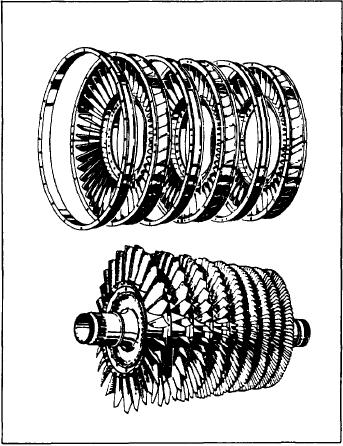
Air from the compressor section goes to the
of air available. The pulsejet proved that the more
combustion chamber. This is the area where fuel
air an engine could compress the greater the power
and air are mixed and ignited. The burning of this
(thrust) it produced. Now we will learn how a gas
fuel/air mixture produces hot, expanding gases
turbine engine increases air compression to
that rush into the turbine rotors. The turbine
develop the tremendous amount of thrust used in
rotors attach to the same shaft as the compressor
modern aircraft.
rotors; so the turbine drives the compressor
making the engine self-sustaining. Finally, the
exhaust gases exit the engine (fig. 1-10) as jet
GAS TURBINE ENGINE
thrust.
Now that you have a basic understanding of
The compressor is the greatest single reason
jet propulsion, let's look at the physical principles
the gas turbine engine runs and produces the
of jet propulsion.
thrust needed in modern aircraft. We will discuss
compressors in greater detail later, but for now
let's keep with the basics. A basic axial-flow
PHYSICAL PRINCIPLES OF
compressor is a shaft with blades attached in rows,
JET PROPULSION
called a rotor. When the rotor shaft turns, the
blades pull air into the engine. It is directed to
Physical principles govern the action of
a set of stationary blades, called stator vanes
matter, motion, force, and energy. You study the
(fig. 1-9). The stator vanes direct air into the next
actions in physics. An English scientist, Sir Isaac
set of compressor vanes. Each set of blades and
Newton, stated three laws of motion explaining
vanes increases the compression of the air used
jet propulsion. Another scientist, Bernoulli,
for combustion. The greater the number of stages,
explains the principle behind the convergent/
the higher the compression ratio.
divergent ducts we discussed earlier. These laws
and principles have words or terms with specific
meanings. Understanding the exact meaning of
the words is the key to understanding the
principles of physics. So let's define some of the
basic terms of physics we need for a good
understanding of jet propulsion.
DEFINITION OF TERMS
Force is the action or effect on a body that
changes the state of motion of the body. A force
may move a body at rest, or it could increase/
decrease the speed of a body, or change the
direction of motion. The application of a force
does not necessarily result in a change in motion.
A force is any push or pull acting on a body.
Water in a can exerts a force on the sides and
bottom of the can. A tugboat exerts a push or pull
(force) on a barge. A man leaning against a
bulkhead exerts a force on the bulkhead.
Matter is anything that occupies space and has
weight.
Mass is the quantity of matter in a body
measured in relation to its inertia. Mass and
weight are similar terms, and they are often
confused with each other. Weight is the common
measurement to determine the quantity of matter
wit h the pull of gravity on it. The following
example will help you understand the difference
Figure 1-9.-Rotor and stator elements of an axial-flow
between weight and mass. A person weighing 164
compressor.
1-4

